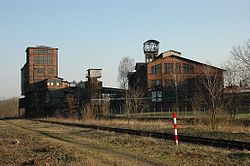
Michálkovice
Encyclopedia

Ostrava
Ostrava is the third largest city in the Czech Republic and the second largest urban agglomeration after Prague. Located close to the Polish border, it is also the administrative center of the Moravian-Silesian Region and of the Municipality with Extended Competence. Ostrava was candidate for the...
, Moravian-Silesian Region
Moravian-Silesian Region
Moravian-Silesian Region , or Moravo-Silesian Region, is one of 14 administrative Regions of the Czech Republic, until May 2001 it was formerly called the Ostrava Region . The region is located in the north-eastern part of its historical region of Moravia and in most of the Czech part of the...
in the Czech Republic
Czech Republic
The Czech Republic is a landlocked country in Central Europe. The country is bordered by Poland to the northeast, Slovakia to the east, Austria to the south, and Germany to the west and northwest....
.
It lies in the historical region of Cieszyn Silesia
Cieszyn Silesia
Cieszyn Silesia or Těšín Silesia or Teschen Silesia is a historical region in south-eastern Silesia, centered around the towns of Cieszyn and Český Těšín and bisected by the Olza River. Since 1920 it has been divided between Poland and Czechoslovakia, and later the Czech Republic...
and was first mentioned in a written document in 1440. It witnessed heavy industrialization in the second half of the 19th century and several coal mines were dug here, most important was Michal Coal Mine.
In 1907 Michálkovice gained a market town
Market town
Market town or market right is a legal term, originating in the medieval period, for a European settlement that has the right to host markets, distinguishing it from a village and city...
rights. Formerly an independent municipality, in 1941 it became a part of Ostrava.
According to the Austrian
Austria-Hungary
Austria-Hungary , more formally known as the Kingdoms and Lands Represented in the Imperial Council and the Lands of the Holy Hungarian Crown of Saint Stephen, was a constitutional monarchic union between the crowns of the Austrian Empire and the Kingdom of Hungary in...
census of 1910 the market town had 6,818 inhabitants, 6,794 of whom had permanent residence there. Census asked people for their native language, 4,147 (61%) were Czech-speaking and 2,481 (36.5%) were Polish-speaking. Most populous religious groups were Roman Catholics with 6,560 (96.2%), Protestants with 142 (2%) and the Jews
Jews
The Jews , also known as the Jewish people, are a nation and ethnoreligious group originating in the Israelites or Hebrews of the Ancient Near East. The Jewish ethnicity, nationality, and religion are strongly interrelated, as Judaism is the traditional faith of the Jewish nation...
with 108 (1.6%).
The most important landmark in Michálkovice is inactive Michal Coal Mine which is a National Cultural Landmark.

